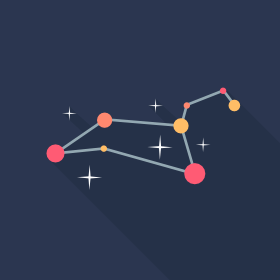
The major scale is one of the most useful pieces of music theory you can learn. It can help you understand a number of musical concepts, such as:
- intervals
- chord construction
- chord progressions
- melodies
In short, can help you in understanding the underlying structure of music. In this article, you'll learn how the major scale is constructed and how you play it on guitar.
How is the major scale constructed?
Let’s start with an example. Here’s the D major scale:
Now let's compare that with the Bb major scale:
Now, we call both of these scales ‘major’. But, looking at these two lists of notes, it’s pretty hard to tell what they have in common. They hardly have any of the same notes. Why then are these two scales both considered ‘major scales’, when they seem to be so different?
The secret structure of scales
We can find the answer by looking at the underlying structure of the major scale. Instead of looking at the note names, we need to analyse the relationships between the notes. More specifically, we’ll look at the distance between the notes: the intervals.
Here’s how that works. Let’s take another look at our Bb major scale. Here’s how you’d play it on the fretboard.

Now, to understand how it is constructed, we need to look at the interval between the first note in the scale and all the other notes.
The first note in the scale is usually called the ‘tonic’. You might also know it as the ‘root’, but we’ll use 'tonic' here. The tonic is quite a special note in our scale. For one, the tonic determines what we call our scale. So in an F major scale, the tonic, the first note in the scale, is F.
Now to uncover the secret structure of the major scale, let’s look at the distance, or interval, between the tonic and the other notes.
- The distance between the tonic and the second note is two frets. Two frets is the same as a major second interval.
- The distance between the tonic and the third note in the scale is four frets, which is a major third interval.
- The fourth note in the scale is five frets higher, which is a perfect fourth.
You get the idea. When we continue this analysis, this is what we get.
Now, if we’d do the same for the d major scale, we’d get this:
Looks familiar doesn’t it? The intervals are the exact same!
We can see this in action on the fretboard as well.
Let’s compare the Bb major scale and the D major scale on the fretboard. Here’s Bb major again:

And here’s the D major scale.
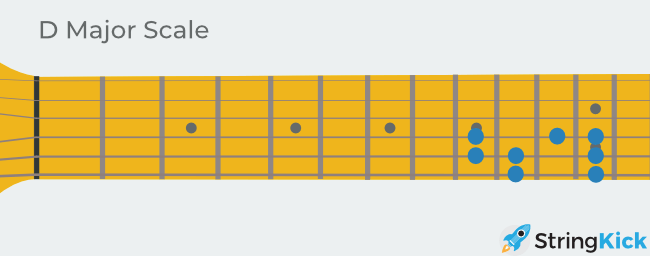
Looks similar doesn’t it? Even though we’re playing the scale at a different position on the neck, the fretboard shape is the exact same. That’s because they both follow the major scale 'recipe'!
We can apply this recipe on different positions on the fretboard. That's what we'll explore in the next section!
Major scale patterns on the fretboard
Let’s recap really quickly. The major scale has a ‘recipe’ that consists of ‘ingredients’. Here’s our list of ‘interval ingredients’:
Now, we can play this in any way we like. For example, we can even play the major scale on the same string. That would look like this:

Of course, playing a scale on one string isn’t super convenient. It’s easier when we can play the scale in the same position. For example, in the last section, we played the major scale like this:
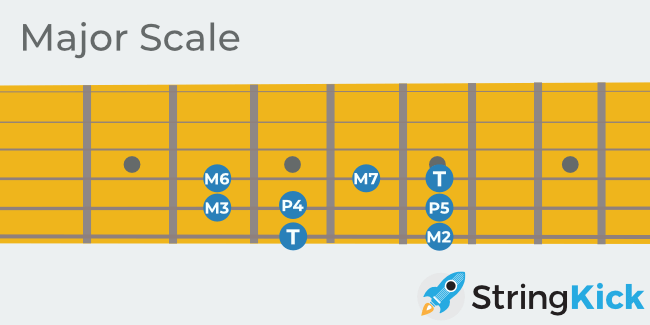
Of course, we don’t have to start playing the scale on the low E string. We could also start on the D string:
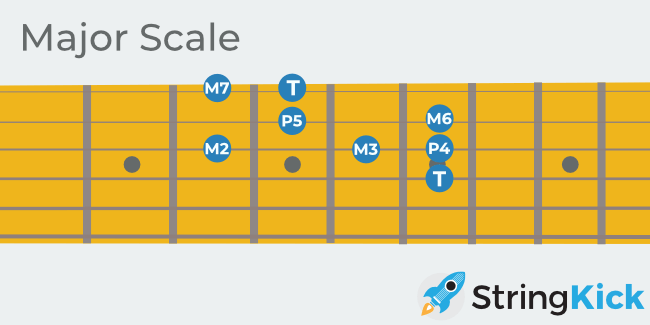
This is the exact same scale, just one octave higher. We can combine these two scale patterns as well.
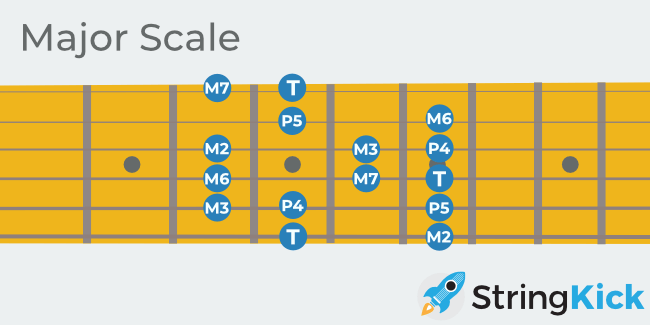
Now, there are more positions on the fretboard where you can play the major scale. And if you’re comfortable with your intervals on guitar, you can figure them out yourself (which is a fantastic way to start learning them).
But before you move on to new positions, let’s check out the position we’ve see just now in action in some real music. By applying the theory to real-world situations, it becomes something that helps you in day-to-day playing.
We’ll take an exercise from my course Music Theory from Scratch, where we analyse a song by the Violent Femmes. Give the song a play and listen to the opening riff. Next, play along with it (if you like) and then see if you can recognise the scale pattern.
Hope that went well for you! Remember that it's okay if you made a lot of mistakes or if this took a lot of time. It simply take practice to get faster and better at this!
Next steps
The most important thing is to see the major scale in action in the songs you like to play. So if you only do one thing, take a song that you know well and apply the theory you learned in this guide. That’s exactly the approach we take in Music Theory from Scratch: by applying theory to real-life musical situations, you’ll start to ‘automagically’ see the secret structure of music.
Any questions or comments about this article? I'd love to hear them. Send me a message here.


![Title image for Learn Music Theory for Guitar [5-step Roadmap]](https://www.stringkick.com/wp-content/uploads/2022/02/Music-Theory-for-Guitar-Main.png)

![Title image for Guitar Intervals: Explained Easily [Full Guide]](https://www.stringkick.com/wp-content/uploads/2023/05/Guitar-Intervals-Title-Image.png)

